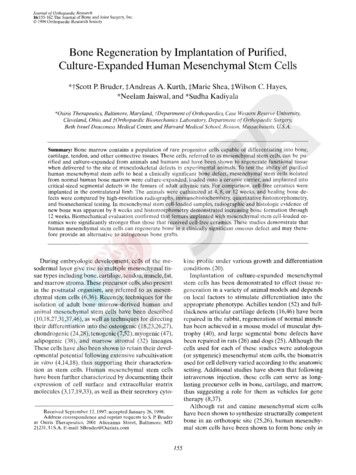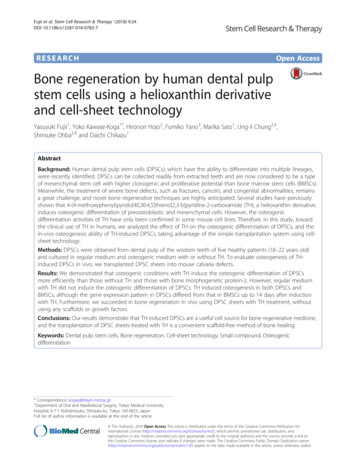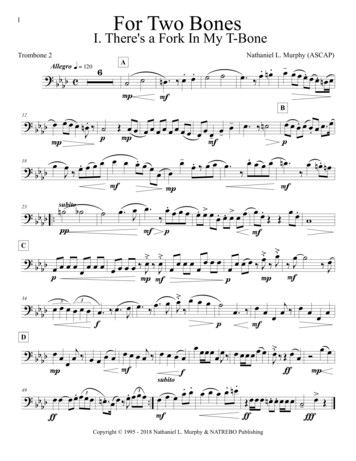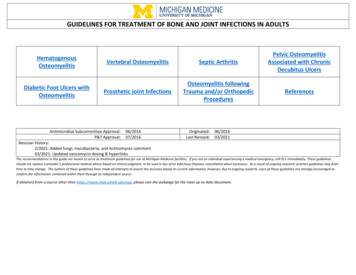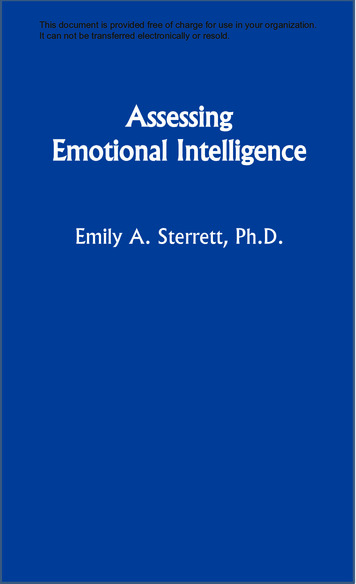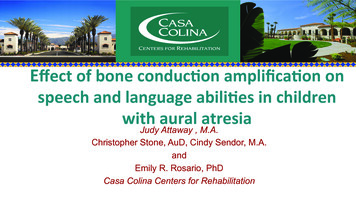
Transcription
uageabili-esinchildrenwithauralatresiaJudy Attaway , M.A.Christopher Stone, AuD, Cindy Sendor, M.A.andEmily R. Rosario, PhDCasa Colina Centers for Rehabilitation
Hypothesis The goal of this study was to investigate the effect of Boneconduction amplification on speech and languagedevelopment for children with aural atresia. Using current atresia patients in a single Audiology clinic westudied speech and language development as it related to:– the time of first intervention– the compliance with wearing hearing aids and assistivedevices– Differences in right verses left sided atresia– Differences in Bilateral verses unilateral atresia
Study ParticipantsInclusion criteria Male and female3 and 6 years of ageunilateral or bilateral conductive hearing loss due to auralatresiaExclusion criteriaParticipants were excluded from the study if they had anyadditional co-morbidities either acquired or developmental inorigin, such as Down Syndrome, cerebral palsy, or autism.
Study Design: Audiology Evaluation Participants completed an audiology exam which included, In participants currently using an amplification device Thedevice use as evaluated.All participants underwent a speech and language evaluationconducted by a speech pathologist in the child's primarylanguage (English or Spanish) using,parent or legal guardian for each subject was asked tocomplete the Children’s Outcomes Worksheet (COW)
Results: Participant Characteristics
Time of first amplificationTime Between Birth and 1st Amplification Device3530Months2520151050BilateralUnilateralWhen comparing individuals with unilateral or bilateral aural atresia weobserved that bilateral subjects on average were first fit with devices at ayounger age than unilateral subjects.
Aid use dailyAid Use lBilateral subjects report / log significantly longer daily use thanunilateral subjects.
Effect of AmplificationAverage reported changeChange Following tiesParents perceived greater improvement in response to sounds asmeasured by the COW in bilateral subjects versus unilateral subjects;however, parents did not perceive a difference in their child’s ability toact on the sounds in the environment.
Speech and Language DelaysSpeech and Language ralUnilateral There were no significant difference in speech and language abilities (asmeasured with the PLS-4, EOWPVT and ROWPVT) between bilateral andunilateral subjects. The bilateral participants did show a trend towards exhibiting greater speechand language delays.
Speech and Language DelaysDevelopmental Delays by AgeAge, Years6420Typical DevelopmentMIld DelaysSevere DelaysWhen speech and language delays (mean of the 3 tests) were analyzedaccording to severity we found that those with severe delays were theoldest,
Speech and Language DelaysTime between birth and 1st fitting(months)Developmental delays and timebetween birth and 1st amplification device50403020100Typical DevelopmentMIld DelaysSevere DelaysChildren who are fit with their first amplification device later exhibitmore severe speech and language delays.
Developmental delays (months)Developmental DelaysDifferences between right and left side atresiaon developmental delaysRightLeft100-10*-20-30RightLeft Interestingly, among children with developmental delays those with right-sidedatresia displayed greater delays. When looking at just the children with right sided atresia, typically developingchildren were fit on average one year earlier.
Conclusions Our study suggests that once aided, children with bilateral atresiadisplay the same delays as those with unilateral atresia. The earlier the children were fit, the more compliant they were atwearing the devices than children fit later. It goes to reason that children fit young will become accustomedto the use of the band since the device which must be worn fairlytight and can be uncomfortable. Older children show greater resistance to the devices andultimately demonstrate less use and less benefit.
Conclusions While the sample size is small this data suggests that fittingchildren earlier may prevent some delays especially withright-sided atresia Right-sided children who developed normal speech andlanguage were fit one year earlier than the right-sidedchildren with delays It is the right ear that is typically the dominant ear forprocessing speech information. It goes to reason that hearing loss on the right could leadto more significant speech and language delays. The normal development of these auditory pathways isessential to learning and success in the classroom.
THANKYOU!Supporting this Research: Casa Colina Foundation and Casa Colina Board of Directors
References ASHA,AmericanSpeech- ‐Language- ‐HearingAssocia5on.(2008).Losstofollow- elopmentinhearing- ialfora'Languagetestforhearing- yngol,65(1),15- inicalPrac5ceGuidelines- gy.Hayiou- Res,53(2),311- ‐332.doi:53/2/311[pii]10.1044/1092- ‐4388(2009/07- ldren.Laryngoscope,123(9),2270- ‐2275.doi:10.1002/lary.24055Klee,T.M.,&Davis- g- ‐impairedchildrenandnormal- ests.EarHear,7(1),27- ‐37.Lieu,J.E.(2004).Speech- 0(5),524- ]
References Lieu,J.E.,Tye- ilateralhearinglossisassociatedwithworsespeech- 8- ‐1355.doi:peds.2009- ‐2448[pii]10.1542/peds.2009- drenwithSingle- ‐SidedDeafness.SeminarsinHearing,31(4),290- dsAmplif,12(1),43- - ‐166.Peckham,C.S.,&Sheridan,M.D.(1976).Follow- ringlossat7years.ChildCareHealthDev,2(2),107- ol,85(9),755- characteris5csofano5aandmicro5ainCalifornia,1989- ‐1997.BirthDefectsResAClinMolTeratol,70(7),472- ‐475.doi:10.1002/bdra.20042
Casa Colina Centers for Rehabilitation . Hypothesis . Using current atresia patients in a single Audiology clinic we studied speech and language development as it related to: – the time of first intervention – t
